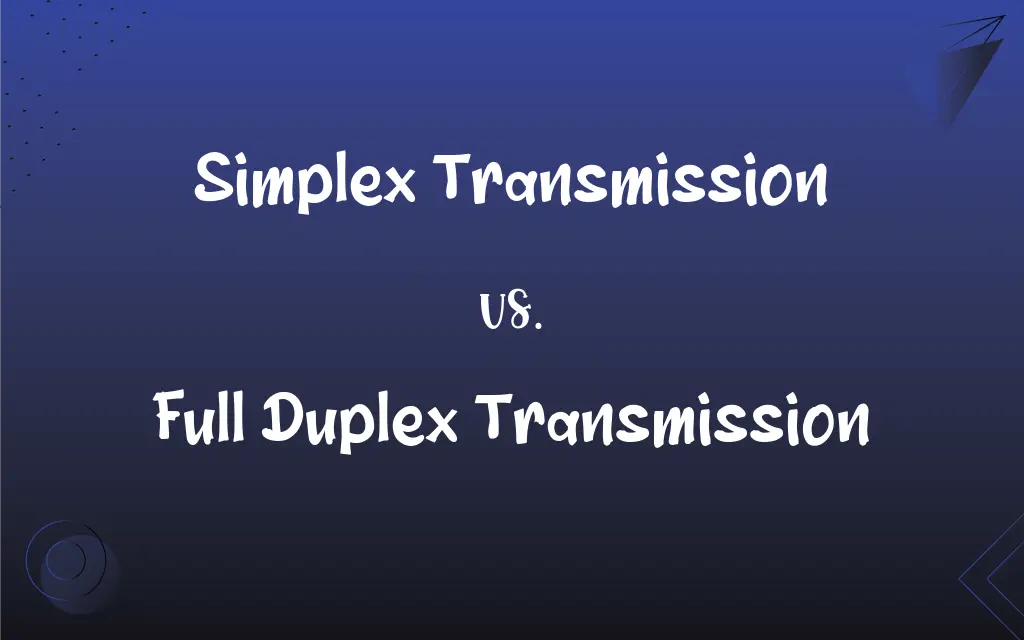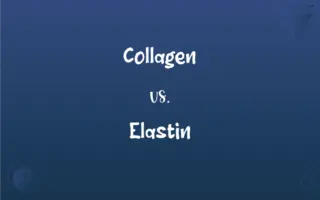Simplex Transmission vs. Full Duplex Transmission: What's the Difference?
Edited by Aimie Carlson || By Harlon Moss || Updated on October 27, 2023
Simplex transmission sends data in one direction only; full duplex transmission allows simultaneous two-way communication.

Key Differences
Simplex transmission is a mode of communication where data can only be sent in one direction, and there's no capability for the receiving end to send data back to the originating source. On the other hand, full duplex transmission allows for data to be sent and received simultaneously, enabling two-way communication between devices.
In simplex transmission, a device is clearly defined as either a sender or a receiver. For instance, a radio broadcast is an example of simplex because the radio station broadcasts the signals, and listeners' radios receive them, but the listeners can't send signals back to the station using the same channel. In contrast, in full duplex transmission, devices can both send and receive data simultaneously, much like a telephone conversation where both parties can speak and listen at the same time.
When using simplex transmission, there's no need for the sending device to wait for acknowledgment or feedback from the receiving device. This might be ideal for scenarios where feedback is unnecessary or not feasible. Conversely, with full duplex transmission, since data flows in both directions, devices can exchange control signals, acknowledgments, and data almost instantaneously.
Applications that require only one-way communication might prefer simplex transmission for its simplicity and straightforwardness. For instance, emergency broadcast systems might utilize simplex. In contrast, applications like internet communication, which involves continuous back-and-forth data exchange, predominantly rely on full duplex transmission for efficiency.
Comparison Chart
Direction of Data Flow
One way (either send or receive)
Two-way (both send and receive)
ADVERTISEMENT
Communication Simultaneity
Only one party can communicate at a time
Both parties can communicate simultaneously
Device Role
Device is either sender OR receiver
Device can be both sender AND receiver
Feedback/Acknowledgment
Not possible from the receiver end
Possible and often instant
Typical Use Cases
Radio broadcasts, emergency alerts
Telephones, internet communication
Simplex Transmission and Full Duplex Transmission Definitions
Simplex Transmission
Communication where one endpoint is a dedicated sender, the other a dedicated receiver.
Digital billboards receive content updates via simplex transmission.
ADVERTISEMENT
Full Duplex Transmission
The ability for devices to send and receive data packets concurrently.
Network routers operate on full duplex transmission to manage vast amounts of data.
Simplex Transmission
A method where a device can either send or receive data, but not both.
The loudspeaker system in a public event operates on simplex transmission.
Full Duplex Transmission
A system where feedback or acknowledgment can be immediate due to two-way communication.
Online gaming requires full duplex transmission for real-time player interactions.
Simplex Transmission
A unidirectional flow of data without the ability for feedback.
Warning sirens work on simplex transmission, alerting residents without receiving input.
Full Duplex Transmission
Two-way communication where both devices can play sender and receiver roles.
Video conferencing platforms leverage full duplex transmission for seamless interactions.
Simplex Transmission
Transmission without the provision for the receiver to communicate back.
The push to talk feature in walkie-talkies often uses simplex transmission.
Full Duplex Transmission
Communication method where data flows bi-directionally without interruptions.
Modern internet connections utilize full duplex transmission for efficient data exchange.
Simplex Transmission
A communication mode where data flows in one direction only.
Radio broadcasts utilize simplex transmission; listeners receive but cannot send back.
Full Duplex Transmission
A mode allowing simultaneous sending and receiving of data.
Telephones use full duplex transmission, letting both parties talk and listen concurrently.
FAQs
Can simplex transmission support two-way conversations?
No, simplex transmission supports only one-way communication.
What is simplex transmission?
Simplex transmission is a mode where data flows in one direction only, either sending or receiving.
Is a radio broadcast an example of simplex transmission?
Yes, radio broadcasts are examples of simplex transmission where stations send signals without receiving input.
Can devices using simplex transmission send feedback?
No, devices using simplex transmission can't send feedback or acknowledgments.
Can devices using full duplex transmission provide instant feedback?
Yes, full duplex transmission allows for instant feedback or acknowledgments due to its two-way nature.
Is a telephone conversation an example of full duplex transmission?
Yes, telephone conversations use full duplex transmission, allowing both parties to speak and listen simultaneously.
Why might an application use simplex transmission?
Applications that require only one-way communication, like emergency alerts, might use simplex for its straightforwardness.
Which is more complex in terms of hardware: simplex or full duplex transmission?
Full duplex transmission is typically more complex as it requires mechanisms to handle simultaneous two-way communication.
Does full duplex transmission mean data flows constantly in both directions?
Yes, in full duplex transmission, data can flow continuously in both directions without interruption.
Can a device switch between simplex and full duplex modes?
Depending on the device's design and purpose, it might be able to switch between simplex and full duplex modes.
Why is full duplex transmission important for the internet?
Full duplex transmission is crucial for the internet as it enables efficient back-and-forth data exchanges for activities like browsing and video streaming.
How does simplex transmission differ from half-duplex?
Simplex transmission is one-way only, while half-duplex allows two-way communication but not simultaneously.
In which scenarios is full duplex transmission not beneficial?
In scenarios where only one-way communication is required or feedback isn't needed, full duplex transmission might be unnecessary.
Why is full duplex transmission more efficient in certain scenarios?
Full duplex transmission allows continuous bidirectional data flow, making it more efficient for tasks needing immediate feedback or acknowledgment.
Can you convert a simplex transmission system to full duplex?
Theoretically, with significant modifications to hardware and protocols, one might convert a simplex system to full duplex, but it's often more practical to design for the desired mode from the start.
What is full duplex transmission?
Full duplex transmission allows simultaneous two-way communication, enabling both sending and receiving of data.
Are walkie-talkies always simplex transmission devices?
While many walkie-talkies use simplex transmission for "push to talk", some models may support full duplex communication.
Are there limitations to using simplex transmission in modern tech?
Yes, as many modern technologies require two-way interactions, the one-directional nature of simplex transmission can be limiting.
How does noise affect simplex and full duplex transmissions?
Noise can degrade the quality of signals in both simplex and full duplex, but full duplex might have more mechanisms to handle and correct such issues.
Are there any security concerns with using either simplex or full duplex transmission?
Both can be subject to security vulnerabilities, but concerns might differ based on the specific application and environment.
About Author
Written by
Harlon MossHarlon is a seasoned quality moderator and accomplished content writer for Difference Wiki. An alumnus of the prestigious University of California, he earned his degree in Computer Science. Leveraging his academic background, Harlon brings a meticulous and informed perspective to his work, ensuring content accuracy and excellence.
Edited by
Aimie CarlsonAimie Carlson, holding a master's degree in English literature, is a fervent English language enthusiast. She lends her writing talents to Difference Wiki, a prominent website that specializes in comparisons, offering readers insightful analyses that both captivate and inform.































































